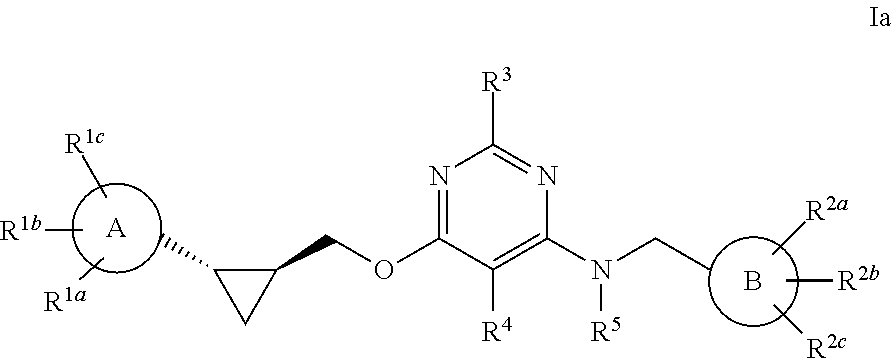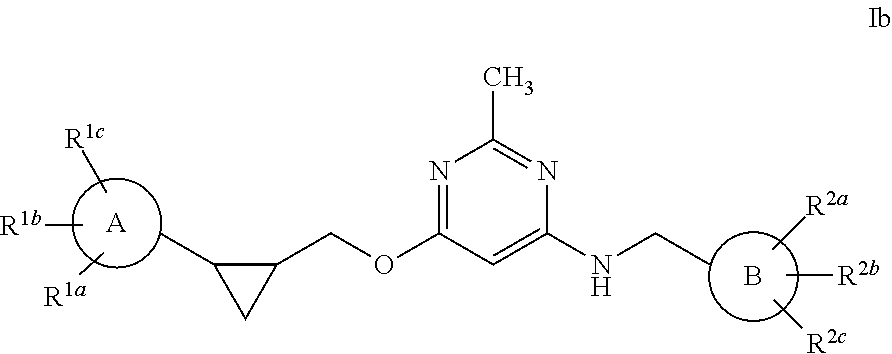Pyrimidine PDE10 inhibitors
a technology of pyrimidine and pde10, which is applied in the field of compounds, can solve the problems of high non-compliance or discontinuation rate of medication, lack of efficacy, and dissatisfaction with therapy
- Summary
- Abstract
- Description
- Claims
- Application Information
AI Technical Summary
Benefits of technology
Problems solved by technology
Method used
Image
Examples
example 1
[0333]
6-chloro-2-methyl-N-((1-methyl-1H-pyrazol-4-yl)methyl)pyrimidin-4-amine (1-1)
[0334]To a stirred solution of 4,6-dichloro-2-methylpyrimidine (100 mg, 0.61 mmol) in dioxane (1 mL) was added triethylamine (0.3 mL, 2.15 mmol) and (1-methyl-1H-pyrazol-4-yl)methanamine (68 mg, 0.61 mmol). The resulting mixture was microwave irradiated at 150° C. for 30 minutes. The reaction was diluted with ethyl acetate and washed with saturated sodium bicarbonate solution. The organic phase was concentrated and flash column separation using a 10-100% ethyl acetate / hexane gradient gave 1-1 as a white solid (121 mg, 83%). MS (M+H)+: observed=238.0857, calculated=238.0854.
2-methyl-N-[(1-methyl-1H-pyrazol-4-yl)methyl]-6-[(2-pyridin-2-ylcyclopropyl)methoxy]pyrimidin-4-amine (1-2)
[0335]To a stirred solution of A-4 (188 mg, 1.26 mmol) in THF (2.5 mL) was added sodium hydride 60% dispersion (74 mg, 1.85 mmol) and the resulting solution was stirred at room temperature for 20 minutes. To this was added 1-1 ...
example 2
[0336]
4-Chloro-2-methyl-6-(((1S,2S)-2-(5-methylpyridin-2-yl)cyclopropyl)methoxy)-pyrimidine (2-1)
[0337]To a suspension of sodium hydride (103 mg, 2.57 mmol) in THF (6.0 mL) was added (S,S) E-3 (350 mg, 2.14 mmol). The resulting mixture was stirred for 30 min before 4,6-dichloro-2-methylpyridine (419 mg, 2.57 mmol) was added. After heating at 80° C. for 1 hour, the reaction was diluted with ethyl acetate and washed with water and brine. The organic phase was concentrated and flash column chromatography using a 0-40% ethyl acetate / hexane gradient gave 2-1 as a colorless oil (453 mg, 73%). MS (M+H)+: observed=290.35, calculated=290.10.
tert-Butyl ((5-methyl-1,3,4-thiadiazol-2-yl)methyl)(2-methyl-6-(((1S,2S)-2-(5-methylpyridin-2-yl)cyclopropyl)methoxy)pyrimidin-4-yl)carbamate (2-2)
[0338]A solution of 2-1 (100 mg, 0.35 mmol), tert-butyl ((5-methyl-1,3,4-thiadiazol-2-yl)methyl)carbamate (119 mg, 0.52 mmol; for preparation, see D. C. Pryde et al. J. Med. Chem. 2006, 49, 4409-4424), 1 M pota...
example 3
[0341]
4,6-dichloro-2-ethylpyrimidine 3-2
[0342]To a stirred solution of propionimidamide hydrochloride (1.00 g, 9.21 mmol) in ethanol (35 mL) was added sodium ethoxide solution 21% in ethanol (17.25 mL). The resulting solution was stirred 20 minutes at room temperature. To this was added dimethyl malonate (0.97 g, 7.37 mmol) and the resulting solution was heated to 80° C. for 5 hours.
[0343]The solution was allowed to cool and concentrated to dryness. To this solid was added a minimum amount of water and neutralized to pH of 5 using 6N HCl solution. The solution was allowed to sit overnight during which time white solid 3-1 precipitated out. The solid 3-1 was dissolved in phosphorus oxychloride (5 mL) and heated to reflux for 90 minutes. The solution was concentrated, quenched with ice, and partitioned between ethyl acetate and a saturated sodium bicarbonate solution. The organic phase was concentrated to give 3-2 as an oil (0.60 g, 37%). LRMS (M+H)+: observed=177.1, calculated=177.0....
PUM
| Property | Measurement | Unit |
|---|---|---|
| temperature | aaaaa | aaaaa |
| temperature | aaaaa | aaaaa |
| temperature | aaaaa | aaaaa |
Abstract
Description
Claims
Application Information
 Login to View More
Login to View More - R&D
- Intellectual Property
- Life Sciences
- Materials
- Tech Scout
- Unparalleled Data Quality
- Higher Quality Content
- 60% Fewer Hallucinations
Browse by: Latest US Patents, China's latest patents, Technical Efficacy Thesaurus, Application Domain, Technology Topic, Popular Technical Reports.
© 2025 PatSnap. All rights reserved.Legal|Privacy policy|Modern Slavery Act Transparency Statement|Sitemap|About US| Contact US: help@patsnap.com



